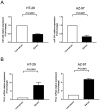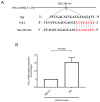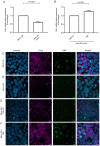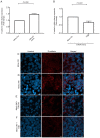Targeting FHL2-E-cadherin axis by miR-340-5p attenuates colon cancer cell migration and invasion
- PMID: 34295384
- PMCID: PMC8273858
- DOI: 10.3892/ol.2021.12898
Targeting FHL2-E-cadherin axis by miR-340-5p attenuates colon cancer cell migration and invasion
Abstract
Convincing data has suggested that four and a half LIM domain 2 protein (FHL2) serves a key function in cancer cell metastasis and that microRNA (miR)-340-5p can regulate cancer cell migration. The current study hypothesized that targeting FHL2 expression by miR-340-5p in colon cancer may attenuate colon cancer cell migration and invasion. FHL2 expression was therefore assessed in colon cancer microarray datasets using Qlucore omics explorer as well as in HT-29 and AZ-97 colon cancer cell lines via reverse transcription-quantitative PCR (RT-qPCR). Colon cancer cell migration and invasion were evaluated in the presence of miR-340-5p mimic, mimic control or mimic with a target site blocker. Confocal microscopy and RT-qPCR were subsequently performed to assess FHL2, E-cadherin (E-cad) protein and mRNA expression in colon cancer cells. Microarray dataset analysis revealed that FHL2 expression was lower in primary colon cancer cells compared with normal colonic mucosa. It was revealed that the expression of miR-340-5p and FHL2 were inversely related in serum-grown and low-serum conditions in HT-29 and AZ-97 cells. Short-time serum exposure to low-serum grown cells induced FHL2 expression. Transfection of HT-29 cells with miR-340-5p mimic not only decreased serum-induced expression of FHL2 but also decreased cancer cell migration and invasion. Bioinformatics analysis revealed that FHL2 mRNA had one putative binding site for miR-340-5p at the 3-untranslated region. Blocking of the target site using a specific blocker reverted miR-340-5p mimic-induced inhibition of FHL2 expression and cancer cell migration and invasion. Confocal microscopy confirmed that the reduction of FHL2 expression by miR-340-5p mimic also reversed serum-induced E-cad disruption and that the target site blocker abrogated the effect of miR-340-5p. The current results suggested that miR-340-5p could be used to antagonize colon cancer cell metastasis by targeting the FHL2-E-cad axis.
Keywords: cell migration; colon cancer; four and a half LIM domains protein 2; metastasis; microRNAs.
Copyright: © Algaber et al.
Conflict of interest statement
The authors declare that they have no competing interests.
Figures







Similar articles
-
MicroRNA-340-5p inhibits colon cancer cell migration via targeting of RhoA.Sci Rep. 2020 Oct 9;10(1):16934. doi: 10.1038/s41598-020-73792-9. Sci Rep. 2020. PMID: 33037251 Free PMC article.
-
MiR-155-5p positively regulates CCL17-induced colon cancer cell migration by targeting RhoA.Oncotarget. 2017 Feb 28;8(9):14887-14896. doi: 10.18632/oncotarget.14841. Oncotarget. 2017. PMID: 28146427 Free PMC article.
-
The CircRNA-ACAP2/Hsa-miR-21-5p/ Tiam1 Regulatory Feedback Circuit Affects the Proliferation, Migration, and Invasion of Colon Cancer SW480 Cells.Cell Physiol Biochem. 2018;49(4):1539-1550. doi: 10.1159/000493457. Epub 2018 Sep 13. Cell Physiol Biochem. 2018. PMID: 30212824
-
MiR-155-5p controls colon cancer cell migration via post-transcriptional regulation of Human Antigen R (HuR).Cancer Lett. 2018 May 1;421:145-151. doi: 10.1016/j.canlet.2018.02.026. Epub 2018 Feb 20. Cancer Lett. 2018. PMID: 29471005
-
miR-6716-5p promotes metastasis of colorectal cancer through downregulating NAT10 expression.Cancer Manag Res. 2019 Jun 6;11:5317-5332. doi: 10.2147/CMAR.S197733. eCollection 2019. Cancer Manag Res. 2019. PMID: 31239781 Free PMC article.
Cited by
-
The roles of FHL2 in cancer.Clin Exp Med. 2023 Nov;23(7):3113-3124. doi: 10.1007/s10238-023-01076-3. Epub 2023 Apr 27. Clin Exp Med. 2023. PMID: 37103649 Review.
-
Expression of Long Nonencoding Ribonucleic Acid SNHG20 in Colon Cancer Tissue in Its Influences on Chemotherapeutic Sensitivity of Colon Cancer Cells.Biomed Res Int. 2022 Jul 23;2022:4752782. doi: 10.1155/2022/4752782. eCollection 2022. Biomed Res Int. 2022. Retraction in: Biomed Res Int. 2024 Jan 9;2024:9798548. doi: 10.1155/2024/9798548. PMID: 35915794 Free PMC article. Retracted.
-
FGF23 promotes proliferation, migration and invasion by regulating miR-340-5p in osteosarcoma.J Orthop Surg Res. 2023 Jan 5;18(1):12. doi: 10.1186/s13018-022-03483-w. J Orthop Surg Res. 2023. PMID: 36604721 Free PMC article.
-
The miR-27a/FOXJ3 Axis Dysregulates Mitochondrial Homeostasis in Colorectal Cancer Cells.Cancers (Basel). 2021 Oct 5;13(19):4994. doi: 10.3390/cancers13194994. Cancers (Basel). 2021. PMID: 34638478 Free PMC article.
-
Downregulation of γ-Catenin by miR-195-5p Inhibits Colon Cancer Progression, Regulating Desmosome Function.Int J Mol Sci. 2023 Dec 29;25(1):494. doi: 10.3390/ijms25010494. Int J Mol Sci. 2023. PMID: 38203664 Free PMC article.
References
LinkOut - more resources
Full Text Sources
Miscellaneous
